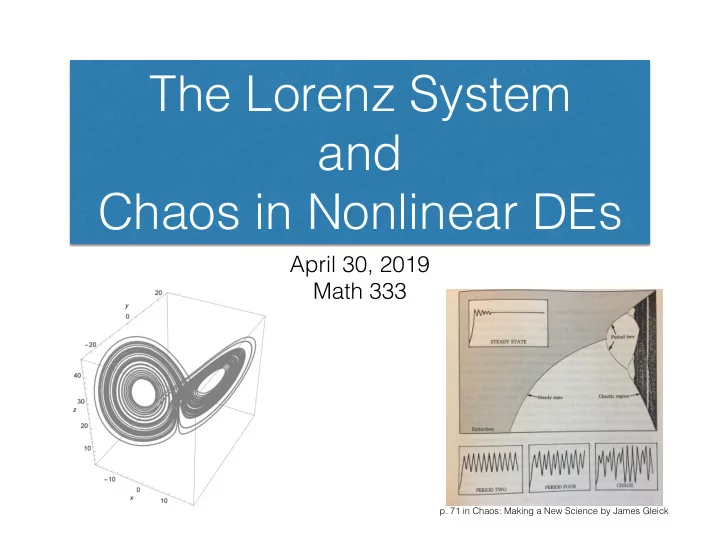

The Lorenz System and Chaos in Nonlinear DEs April 30, 2019 Math 333 p. 71 in Chaos: Making a New Science by James Gleick
Adding a dimension adds new possible layers of complexity in the phase space of a DE. Today we’ll explore what can happen in 3+ dimensions!
Chaos Chaos is aperiodic long-term behavior in a deterministic system that exhibits sensitive dependence on initial conditions. Ex. The Butterfly effect https://en.wikipedia.org/wiki/ Butterfly#/media/ File:Necyria_bellona_manco_No varaExpZoologischeTheilLepido pteraAtlasTaf36.jpg
Randomness Randomness is an indeterministic unpredictable process which may lead to a probability distribution of outcome possibilities. ex. Flipping a coin. https://en.wikipedia.org/ wiki/Coin_flipping#/ media/ File:Coin_Toss_(3635981 474).jpg
Philosophical Analogy: Randomness is to luck as chaos is to fate.
Lorenz, E. N. (1963). Deterministic nonperiodic flow. Journal of the atmospheric sciences, 20(2), 130-141.
<latexit sha1_base64="f5AQtWU+evArOEqDxMT89hqrcfI=">ACP3icbZBLSwMxFIUzvq2vqks3wSIo0jJTBd0IohuXCrYKTSmZTKYNZh4kd2SmQ/+ZG/+CO7duXCji1p1pO+DzQuBwvnu5uceNpdBg24/WxOTU9Mzs3HxpYXFpeaW8utbUaIYb7BIRurapZpLEfIGCJD8OlacBq7kV+7N6ZBf3XKlReQhbzdkC7ofAFo2CsTrlJfEVZ7qWD3IPBEdGiG9DtrJruEFIqWFYw1Ytwiqs4w9W0/4X7Y1wlLgeK+7tpRkinXLFr9qjwX+EUoKOu+UH4gXsSTgITBJtW45dgztnCoQTPJBiSax5Td0C5vGRnSgOt2Prp/gLeM42E/UuaFgEfu94mcBlpngWs6Awo9/ZsNzf9YKwH/sJ2LME6Ah2y8yE8khgPw8SeUJyBzIygTAnzV8x61KQCJvKSCcH5fJf0azXnL1a/WK/cnxSxDGHNtAm2kYOkDH6AydowZi6A49oRf0at1bz9ab9T5unbCKmX0o6yPT8gTr+4=</latexit> <latexit sha1_base64="ZMdEKtY7bDScV0znw+23YIaJfYc=">ACDHicbVDLSgMxFM34rPVdekmWAQXUmdawW4KRTcuK9gHdIaSTNtaB5DkhHK0A9w46+4caGIWz/AnX9j2s5CWw8JnJx7Ljf3hDGj2rjut7Oyura+sZnbym/v7O7tFw4OW1omCpMmlkyqTog0YVSQpqGkU6sCOIhI+1wdDOtx+I0lSKezOScDRQNCIYmSs1CsUfU0HNU89xz69oTEoFr1ojJ/qaGslavW5ZbcGeAy8TJSBkavcKX35c4UQYzJDWXc+NTZAiZShmZJL3E01ihEdoQLqWCsSJDtLZMhN4apU+jKSyVxg4U393pIhrPeahdXJkhnqxNhX/q3UTE1WDlIo4MUTg+aAoYdBIOE0G9qki2LCxJQgrav8K8RAphI3NL29D8BZXiatcsmrlMp3l8X6dRZHDhyDE3AGPHAF6uAWNEATYPAInsEreHOenBfn3fmYW1ecrOcI/IHz+QOHVJgb</latexit> The Lorenz System dx dt = σ ( y − x ) dy dt = ρ x − y − xz dz dt = − β z + xy σ = 10 , β = 8 / 3 , ρ = 28 Famous parameter set: • Very few nonlinear terms • Seems very simple
<latexit sha1_base64="QB0TmYjcKtRth+Om+dt0Vl8o9YE=">ACPXicbZBNSwMxEIazflu/qh69BIuiYMtuFexFEL2IJwWrQlNKNp2todnskmSl69I/5sX/4M2bFw+KePVqthbxayDhyTszZOb1Y8G1cd0HZ2R0bHxicmq6MDM7N79QXFw61GiGNRZJCJ16VMNgkuoG24EXMYKaOgLuPC7h3n+4hqU5pE8M2kMzZB2JA84o8ZKreLZ8UZvK9262dwjPnS4zPyQGsV7/bLn4nU8uFxCqrXyjaWyl189QnBqoZc/SKAoq20TkO2v3lax5FbcQeC/4A2hIZx0irek3bEkhCkYJq3fDc2DQzqgxnAvoFkmiIKevSDjQsShqCbmaD7ft4zSptHETKHmnwQP3ekdFQ6zT0baWd70r/zuXif7lGYoJaM+MyTgxI9vlRkAhsIpxbidtcATMitUCZ4nZWzK6otcNYwvWBO/3yn/hvFrxtivV053S/sHQjim0glbRBvLQLtpHR+gE1RFDt+gRPaMX585cl6dt8/SEWfYs4x+hP+AcLmqQw=</latexit> <latexit sha1_base64="1SFHiTan/scDeXAjEua0GMBGi94=">ACEHicbVC7TsMwFHV4lvIKMLJYVIhWqokIMpYwcJYJPqQmqhyXKe1aifBdpCqJ/Awq+wMIAQKyMbf4PbZqAtx7J0fM69ur7HjxmVyrJ+jJXVtfWNzdxWfntnd2/fPDhsyigRmDRwxCLR9pEkjIakoahipB0LgrjPSMsf3kz81iMRkbhvRrFxOoH9KAYqS01DXPilZn1IZFt2YX7ryQajUGZfnHk61DULVsWaAi4TOyMFkKHeNb/dXoQTkKFGZKyY1ux8lIkFMWMjPNuIkmM8BD1SUfTEHEivXS60BieaqUHg0joGyo4Vf92pIhLOeK+ruRIDeSiNxH/8zqJCq68lIZxokiIZ4OChEVwUk6sEcFwYqNEFYUP1XiAdIKx0hnkdgr248jJpOhX7vOLcXRq1kcOXAMTkAR2KAKauAW1EDYPAEXsAbeDejVfjw/icla4YWc8RmIPx9QtP85pK</latexit> √ √ Three equilibrium points: (0 , 0 , 0) , ( ± 6 2 , ± 6 2 , 27) − 10 10 0 J ( x, y, z ) = 28 − z − 1 − x − 8 y x 3 At the origin:
<latexit sha1_base64="v6NYMONOeYDdAfOv/De4Me7ZtU=">ACD3icbZDLSgMxFIYz9VbrbdSlm2BRKkqZqWLdCNVuXFawF2hryaRpG5q5mJwRy9A3cOruHGhiFu37nwb03bAS/0h8PGfczg5vxMIrsCyPo3EzOzc/EJyMbW0vLK6Zq5vVJQfSsrK1Be+rDlEMcE9VgYOgtUCyYjrCFZ1+sVRvXrLpOK+dwWDgDVd0vV4h1MC2mqZuw1gdxCdAR4Wr/dPM8cNdSMhyg0PvimX32uZaStrjYWnwY4hjWKVWuZHo+3T0GUeUEGUqtWAM2ISOBUsGqESoWENonXVbX6BGXqWY0vmeId7Txh1f6ucBHrs/JyLiKjVwHd3pEuipv7WR+V+tHkLnpBlxLwiBeXSyqBMKD4ehYPbXDIKYqCBUMn1XzHtEUko6AhTOgT78nTUMl7cNs7vIoXTiP40iLbSNMshGeVRAF6iEyoie/SIntGL8WA8Ga/G26Q1YcQzm+iXjPcv186bQA=</latexit> At C + = (6 √ √ 2 , 6 2 , 27)
<latexit sha1_base64="M1UOf7s5cVUAgplFmWIcD/IoOs=">ACEXicbZC7SgNBFIZnvcZ4i1raDAYhgm7UYyNE1jGcFcILuG2ckGTJ7ceasGJa8go2vYmOhiK2dnW/j5FLExB8GPv5zDmfO74aCKzDNH2NhcWl5ZTWxlzf2NzaTu3sVlUQScoqNBCBrLtEMcF9VgEOgtVDyYjnClZze6VhvfbApOKBfwv9kDke6fi8zSkBbTVTGRvYI8SXgAelu+xFJntmq3sJcX5wPIX5wlEzlTZz5kh4HqwJpNFE5Wbq24FNPKYD1QpRqWGYITEwmcCjZI2pFiIaE90mENjT7xmHLi0UDfKidFm4HUj8f8MidnoiJp1Tfc3WnR6CrZmtD879aI4L2uRNzP4yA+XS8qB0JDAEexoNbXDIKoq+BUMn1XzHtEko6BCTOgRr9uR5qOZz1kuf3OaLl5N4kigfXSAMshCBVRE16iMKoiJ/SC3tC78Wy8Gh/G57h1wZjM7KE/Mr5+AcKQm7A=</latexit> At C − = ( − 6 √ √ 2 , − 6 2 , 27)
p. 536 in Blanchard, Devaney and Hall
Strange Attractor
From Lorenz’s original paper: Strogatz: Numerical experiments suggest the strange attractor has fractal dimension 2.05.
Sensitive Dependence on Initial Conditions Two ICs: (0,1,0) and (0,1.01,0)
Sensitive Dependence on ICs Topological Mixing (Ergocity) from Sarah Iams, Harvard University
If this is interesting and you want to learn more:
References 1. Alligood, Kathleen T, Tim Sauer, and James A. Yorke. Chaos: An Introduction to Dynamical Systems. New York: Springer, 1997. 2. Blanchard, Paul, Robert L. Devaney, and Glen R. Hall. Differential Equations. Boston, MA: Brooks/ Cole, Cengage Learning, 2012. 3. Gleick, James. Chaos: Making a New Science. New York, N.Y., U.S.A: Penguin, 1988. 4. Iams, Sarah. Lorenz Evolution.nb, (2019). 5. Lorenz, Edward N. "Deterministic nonperiodic flow." Journal of the atmospheric sciences 20.2 (1963): 130-141. 6. Strogatz, Steven. Nonlinear Dynamics and Chaos: With Applications to Physics, Biology, Chemistry, and Engineering. Boulder, Colo: Westview Press, 2014. 7. The Internet for some pictures :D 8. Weisstein, Eric W. "Lorenz Attractor." From MathWorld--A Wolfram Web Resource. http:// mathworld.wolfram.com/LorenzAttractor.html 9. Wikipedia: https://en.wikipedia.org/wiki/Randomness 10. Wikipedia: https://en.wikipedia.org/wiki/Edward_Norton_Lorenz
Recommend
More recommend